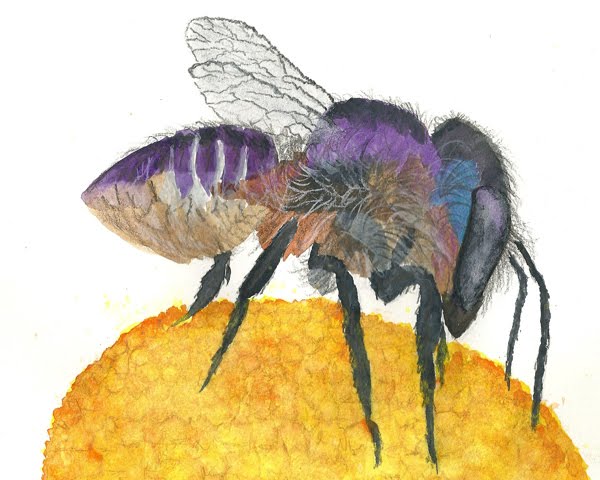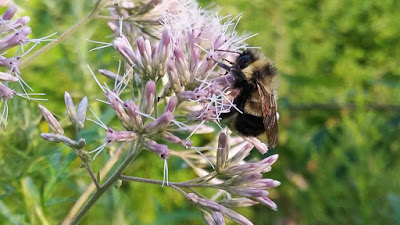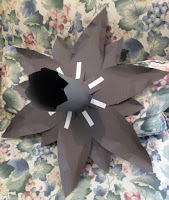Wednesday, September 28, 2016
Friday, September 23, 2016
Thursday, September 22, 2016
Saturday, September 17, 2016
Native Bee Resource
Native Bees of North America
Native bees are an unappreciated treasure, with 4,000 species from tiny Perdita to large carpenter bees, they can be found anywhere in North America where flowers bloom. Most people don’t realize that there were no honey bees in America until the white settlers brought hives from Europe. These resourceful insects promptly managed to escape domestication, forming swarms and setting up housekeeping in hollow trees, other cavities or even exposed to the elements just as they had been doing in their native lands. Native pollinators, in particular bees, had been doing all the pollination in this continent before the arrival of that import from the Old World. They continue to do a great deal of it, especially when it comes to native plants.
See Bugguide.net
Wednesday, September 14, 2016
Making A Maquette/Patter For A Metal Flower Sculpture
 I previously made a Mason Bee nesting unit as a metal floral sculpture. It is featured in the 2016 Sculpture in the Garden exhibit at the North Carolina Botanical Garden.
I previously made a Mason Bee nesting unit as a metal floral sculpture. It is featured in the 2016 Sculpture in the Garden exhibit at the North Carolina Botanical Garden.
 Many times, it is useful to create a maquette (a 3D sketch of the intended sculpture) to aid in the visualization and design of the piece. Often, the maquette is smaller than the final sculpture. Sometimes, a full size maquette is made and also serves as a pattern for laying out the image on metal.
Many times, it is useful to create a maquette (a 3D sketch of the intended sculpture) to aid in the visualization and design of the piece. Often, the maquette is smaller than the final sculpture. Sometimes, a full size maquette is made and also serves as a pattern for laying out the image on metal.
For this exercise, I used construction paper to create a maquette/pattern for a metal flower sculpture. I used a commercially available Mason Bee nesting unit as a size reference. It is 6.5 inches long and 3.25 inch diameter.
I used a piece of construction paper (50 x 65 cm) as the building material. I used the bee nest case to form the trumpet of the flower.
I rolled the paper around the tube to define the trumpet template.
The trumpet template was shaped with scissors.
I then secured the shape with artist's tape. The tape is basically used on the paper where welds or rivets will be used with metal.
I cut a petal and a petiol, and used them at as pattern for five more of each.
I taped the petals and petiols.
After taping on the trumpet, I shaped the petals to form a 3D maquette.

I deconstructed the maquette to lay out the intended sculpture pattern on a steel sheet. This facilitated the efficient use of valuable materials.
Monday, September 12, 2016
A Simple Mason Bee Nesting Unit
I just made a really simple Mason Bee nesting unit.
You can make these with 2x4 or 2x6 planks of wood. I used a 2x4 for this prototype because it is easier to manipulate. I cut the 2x4 into various lengths using my band say. You can easily use a good hand saw. It is just as easy.
I cut a 1x2 plank to equivalent sizes.
I measured and marked for holes 1 inch apart, and used a punch to start the holes.
Using a 7/16 in wood bit, I drilled holes with a hand held drill. If you have a drill press available, It is a lot easier to get nice parallel holes.
I used a circular file to clean out the holes.
I cut a variety of block sizes.
I cut 5 by 5 inch pieces of parchment paper. You can get it in your supermarket. I rolled in around a standard pencil. The resulting tube is 5/16 in in interior diameter.
I inserted the paper tubes into the holes in the 2x4s.
The paper tubes will be secured with the 1x2 pieces using wood screws.
Now, I will continue to roll and insert the paper tubes into my 2x4 pieces.
There are myriad ways to use these units. How would you make and utilize these units?
Sunday, September 11, 2016
Friday, September 9, 2016
UNC MakNet
Wondering what exactly MakNet is? We are Carolina’s Maker Network, and our goal is to create a network of makers: people interested in making, well, anything! We bring together people interested in art, philosophy, computer science, biomedical engineering, and pretty much any major here at UNC, and connect them with the resources needed to imagine, design, and create. Learn all about MakNet
Thursday, September 8, 2016
Making A Bee Cube
This is a very easy bee house to build.
I started with a 1 by 8 pine plank. This is really 7 and 1/4 by 3/4 inches in dimension. My friend Bob Oram (all around handy guy) has a table saw and he helped me cut pieces of wood. The back is 7 and 1/4 by 7 and 1/4 inches. Two sides are the same dimensions. Two sides are 7 and 1/4 by 5 and 3/4.
I assembled the pieces into a cube and squared it with clamps.
I glued and screwed the pieces together.
My friend and master bird/bee house builder Art Lituchy helped me cut pieces of roof flashing to fit two sides of the cube.
The flashing was glued and tacked on two sides of the cube. It will hold nesting tubes, pieces of bamboo or small segments of branches. these materials will be good nesting sites for Mason, Leaf Cutter and Carpenter Bees respectively.
Now -- Build it yourself and decorate it to make it uniquely yours.
Tuesday, September 6, 2016
Mosquito Control and Bees
This is a good article, but it does not consider wild native bees.
Let's think more about pesticides and bees.
Forrest
Monday, September 5, 2016
Saturday, September 3, 2016
Mason Bee Nesting Tray Prototype House
I made this prototype house in only a few hours.
 First, I purchased a Mason Bee nesting tray from Crown Bees. The dimensions of the unit are 5.5 in wide, 6.5 in deep and 3.5 in tall. These dimensions determine the design of the house.
First, I purchased a Mason Bee nesting tray from Crown Bees. The dimensions of the unit are 5.5 in wide, 6.5 in deep and 3.5 in tall. These dimensions determine the design of the house.

I purchased a 1 inch by 8 inch pine plank, Tightbond Ultimate glue, stainless steel wood screws and aluminum rood flashing. From the pine plank, I cut pieces for a box shape -- 7.5 in bottom, 6 in sides, 9 in top, and 7.5 in back.
 The box was assembled, glued and screwed.
The box was assembled, glued and screwed.
A piece of the flashing was cut, using a utility knife to fit the roof with some overlap.

Pieces of the flashing were cut to make roof tiles. They were glued and tacked to the roof.

The nesting tray fits just right.
This is just a basic unit. Now, it can be altered and designed to express your individuality, aesthetic sense and the needs of your garden space.
How will you make it your own?
Subscribe to:
Posts (Atom)
































